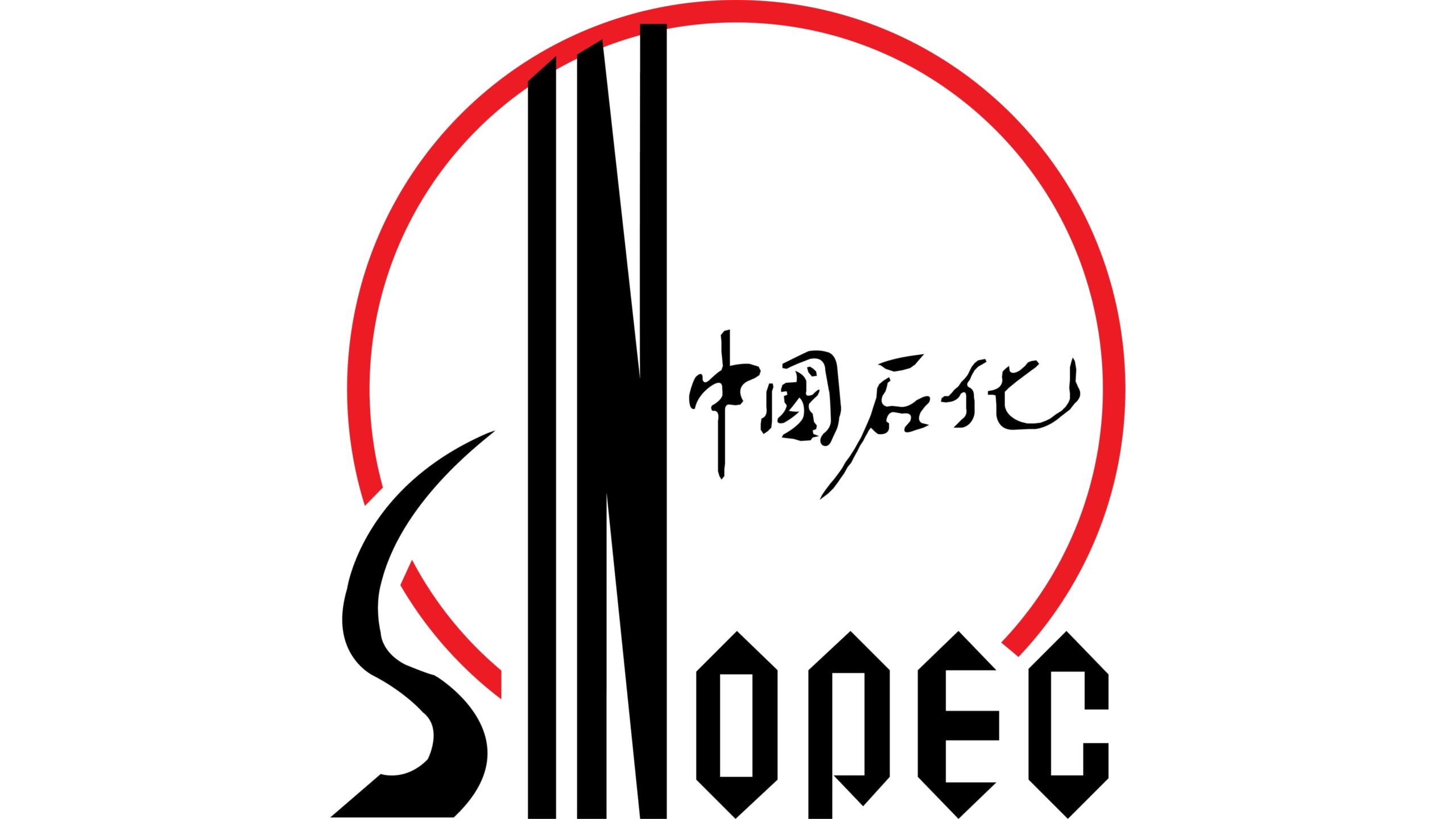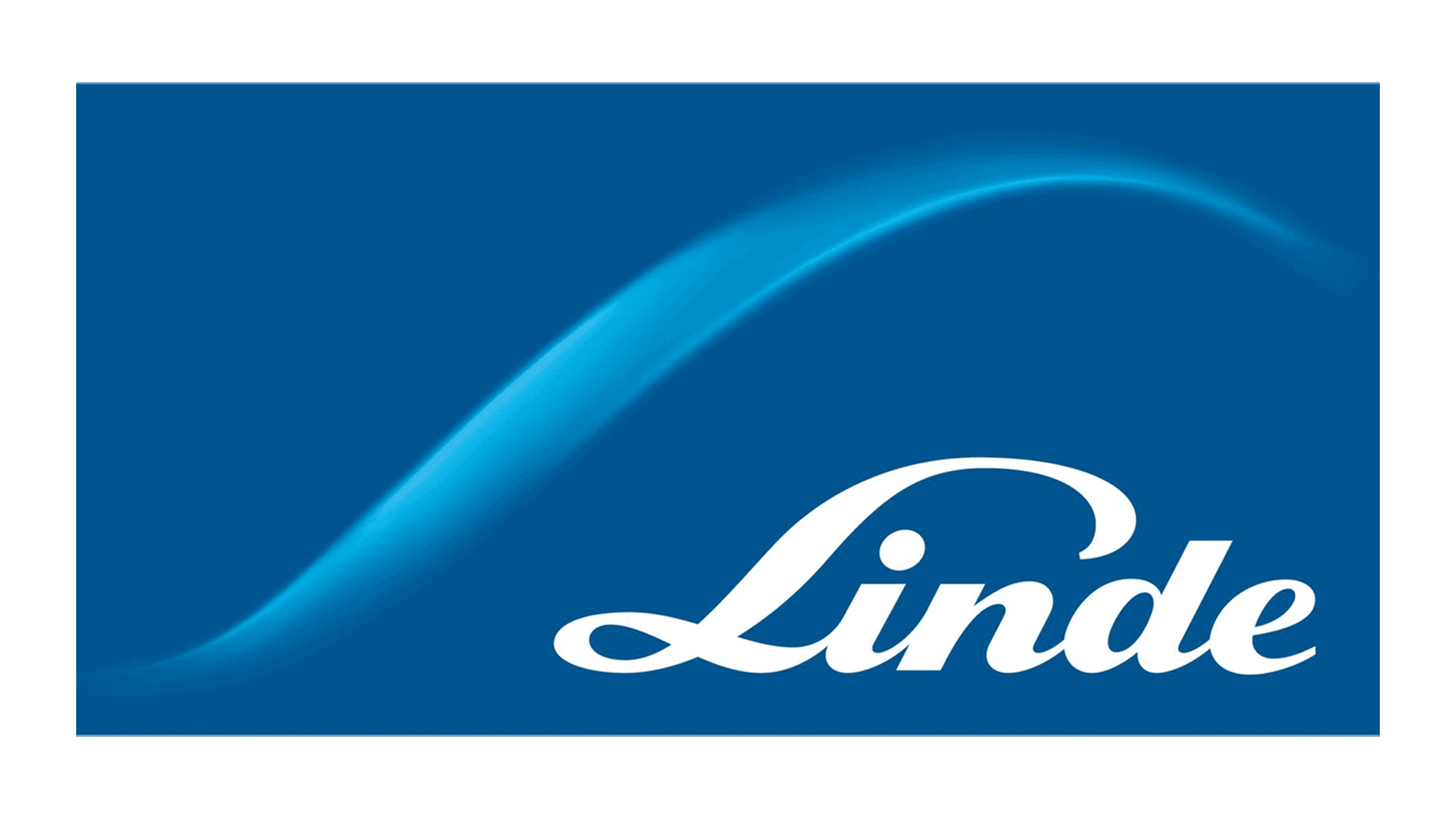Global Refinery Catalyst Market By Ingredients, By Application, By Region & Segmental Insights Trends and Forecast, 2024 – 2034
- Industry: Chemicals & Materials
- Report ID: TNR-110-1249
- Number of Pages: 420
- Table/Charts : Yes
- August, 2024
- Base Year : 2024
- No. of Companies : 10+
- No. of Countries : 29
- Views : 10076
- Covid Impact Covered: Yes
- War Impact Covered: Yes
- Formats : PDF, Excel, PPT
The global refinery catalyst market is experiencing robust growth, driven by increasing demand for cleaner fuels and stringent environmental regulations. Advancements in catalytic technology, such as the development of more efficient and durable catalysts, are enhancing refinery processes and reducing emissions. Opportunities are emerging from the rising adoption of catalytic reforming and hydrocracking technologies to improve fuel quality and meet regulatory standards.
The market is also witnessing a shift towards sustainable and environmentally friendly catalysts, driven by the growing emphasis on reducing carbon footprints. Key trends include the integration of digital technologies for process optimization and the expansion of refinery capacities in emerging economies. The market is poised for continued expansion, supported by innovations in catalyst materials and applications, ensuring improved efficiency and sustainability in refining operations. In terms of revenue, the global refinery catalyst market was worth US$ 5.5 Mn in 2023, anticipated to witness a CAGR of 4.5% during 2024 – 2034.
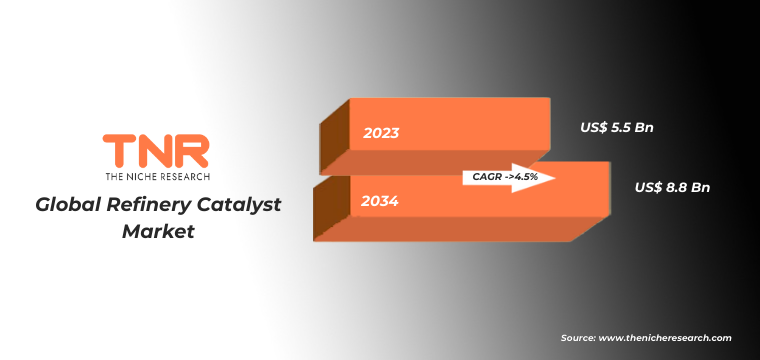
Global Refinery Catalyst Market Dynamics
Global Refinery Catalyst Market Growth Driver:
The global refinery catalyst market benefits from significant technological advancements, enhancing catalyst efficiency and durability. The industry’s growth is underpinned by strict environmental regulations that drive the demand for catalysts capable of producing cleaner fuels. Established players with robust R&D capabilities lead innovation in catalytic processes, such as hydrocracking and catalytic reforming, contributing to improved fuel quality and operational efficiency. Additionally, the ability of advanced catalysts to support higher conversion rates and better yield from feedstock underpins market strength. The market also benefits from strong industry experience and a well-established supply chain network, further reinforcing its resilience and growth potential.
Global Refinery Catalyst Market Restraint:
High costs associated with advanced catalyst materials and technologies can pose financial challenges, particularly for smaller refiners. The complexity of catalyst regeneration and management often results in increased maintenance expenses and operational downtime. Additionally, the reliance on specific raw materials for catalyst production can lead to supply chain vulnerabilities and price volatility. The market also faces challenges related to the need for continuous adaptation to evolving regulatory standards, which may involve significant investment and technological updates. Such factors can strain resources and impact the financial performance of market participants.
Global Refinery Catalyst Market Opportunity:
The global refinery catalyst market presents numerous opportunities driven by rising investments in refinery upgrades and expansions, particularly in emerging economies with growing energy needs. The increasing emphasis on sustainable and eco-friendly catalysts aligns with global trends towards reducing carbon emissions, creating new market segments. Technological advancements in digitalization and automation offer potential for significant improvements in process optimization, efficiency, and cost reduction. Collaborations and strategic partnerships aimed at developing next-generation catalysts can open new avenues for growth and innovation. Additionally, the expanding scope of catalytic applications in various refining processes further enhances market potential.
Global Refinery Catalyst Market Threats:
The global refinery catalyst market faces potential threats from fluctuations in raw material prices, which can impact production costs and supply stability. Geopolitical tensions and trade disruptions may exacerbate these issues, affecting market dynamics. Intense competition among key industry players could lead to pricing pressures, impacting profit margins and market stability. Additionally, rapid changes in regulatory requirements and environmental standards may necessitate continuous investments in catalyst development and adaptation, posing financial and operational challenges. These factors could hinder market growth and impact the strategic positioning of market participants.
Global Refinery Catalyst Market Segmental Analysis:
Global Refinery Catalyst Market By Ingredients
- Zeolites
- Metals
- Chemical Compounds
- Others
Chemical compounds segment has rapidly emerged as the fastest-growing segment in the global refinery catalyst market, driven by advancements in refining processes and the increasing demand for high-quality fuels and petrochemical products. This growth is fueled by the need for more efficient catalysts that can enhance the conversion rates and selectivity of refinery processes, such as hydrocracking, fluid catalytic cracking (FCC), and hydrotreating. Innovations in chemical compounds, particularly zeolites, metals, and acids, are enabling refineries to meet stringent environmental regulations while maximizing output. Additionally, the rise in global energy consumption and the push for cleaner fuels have further accelerated the adoption of advanced chemical compounds in refinery catalysts, making this segment a key driver of market expansion.
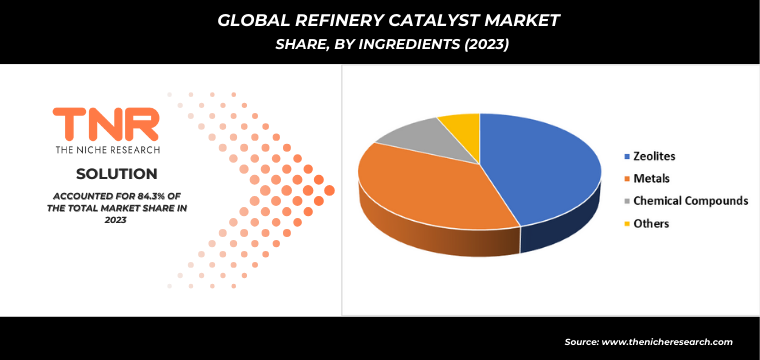
Global Refinery Catalyst Market By Application
- FCC
- Alkylation
- Hydrotreating
- Hydrocracking
- Catalytic Reforming
- Others
In 2023, FCC segment dominated the global refinery catalyst market, capturing a substantial revenue share of 25.9%. This dominance is attributed to FCC’s critical role in converting heavy crude oils into lighter, more valuable products such as gasoline, olefins, and other essential petrochemicals. The segment’s growth is driven by the increasing demand for high-octane gasoline and the rising need for efficient processing of heavier crude oil feedstocks. Additionally, ongoing advancements in FCC technology, which enhance catalyst performance and extend catalyst life, have further solidified its position as a key component in modern refinery operations, contributing significantly to market revenue.
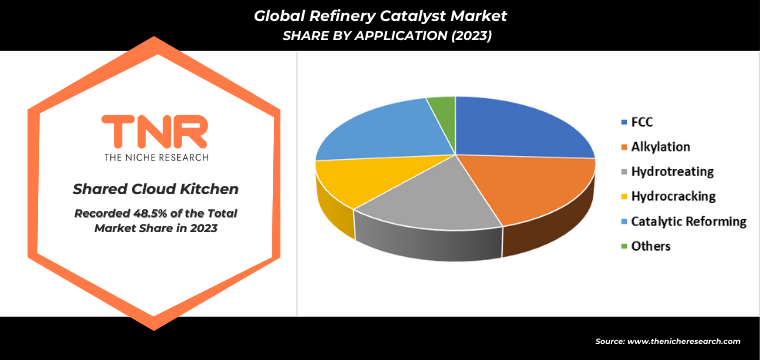
Global Refinery Catalyst Market By Region
- North America (U.S., Canada, Mexico, Rest of North America)
- Europe (France, The UK, Spain, Germany, Italy, Nordic Countries (Denmark, Finland, Iceland, Sweden, Norway), Benelux Union (Belgium, The Netherlands, Luxembourg), Rest of Europe)
- Asia Pacific (China, Japan, India, New Zealand, Australia, South Korea, Southeast Asia (Indonesia, Thailand, Malaysia, Singapore, Rest of Southeast Asia), Rest of Asia Pacific)
- Middle East & Africa (Saudi Arabia, UAE, Egypt, Kuwait, South Africa, Rest of Middle East & Africa)
- Latin America (Brazil, Argentina, Rest of Latin America)
North America is projected to be the fastest-growing region in the refinery catalyst market during the forecast period. The region’s growth is fueled by the increasing production of shale oil and gas, which has led to a higher demand for advanced refining processes. Stringent environmental regulations are pushing refineries to adopt more efficient catalysts to reduce sulfur emissions and produce cleaner fuels. The modernization of aging refineries and significant investments in new refining capacities further bolster this trend. Moreover, the strong presence of major catalyst manufacturers and ongoing technological advancements in catalyst formulations are contributing to North America’s rapid expansion in the global refinery catalyst market.
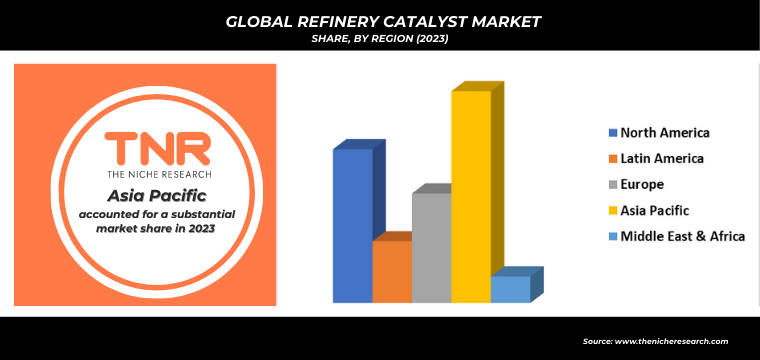
Competitive Landscape
The global refinery catalyst market is highly competitive, with key players including Albemarle Corporation, BASF SE, and W.R. Grace & Co. These companies focus on innovation, strategic partnerships, and expanding product portfolios to maintain market leadership amid increasing demand for efficient refining processes and cleaner fuels.
Some of the players operating in the refinery catalyst market are
- Albemarle Corporation
- BASF SE
- Johnson Matthey Plc
- R. Grace
- Clariant International Ltd.
- Arkema
- Zeolyst International
- Chevron Corporation
- Exxon Mobil Corporation
- Evonik Industries AG
- DuPont
- Haldor Topsoe A/S
- Other Industry Participants
Global Refinery Catalyst Market Scope:
| Report Specifications | Details |
| Market Revenue in 2023 | US$ 5.5 Mn |
| Market Size Forecast by 2034 | US$ 8.8 Mn |
| Growth Rate (CAGR) | 4.5% |
| Historic Data | 2016 – 2022 |
| Base Year for Estimation | 2023 |
| Forecast Period | 2024 – 2034 |
| Report Inclusions | Market Size & Estimates, Market Dynamics, Competitive Scenario, Trends, Growth Factors, Market Determinants, Key Investment Segmentation, Product/Service/Solutions Benchmarking |
| Segments Covered | By Ingredients, By Application, By Region |
| Regions Covered | North America, Europe, Asia Pacific, Middle East & Africa, Latin America |
| Countries Covered | U.S., Canada, Mexico, Rest of North America, France, The UK, Spain, Germany, Italy, Nordic Countries (Denmark, Finland, Iceland, Sweden, Norway), Benelux Union (Belgium, The Netherlands, Luxembourg), Rest of Europe, China, Japan, India, New Zealand, Australia, South Korea, Southeast Asia (Indonesia, Thailand, Malaysia, Singapore, Rest of Southeast Asia), Rest of Asia Pacific, Saudi Arabia, UAE, Egypt, Kuwait, South Africa, Rest of Middle East & Africa, Brazil, Argentina, Rest of Latin America |
| Key Players | Albemarle Corporation, BASF SE, Johnson Matthey Plc, W. R. Grace, Clariant International Ltd., Arkema, Zeolyst International, Chevron Corporation, Exxon Mobil Corporation, Evonik Industries AG, DuPont, Haldor Topsoe A/S |
| Customization Scope | Customization allows for the inclusion/modification of content pertaining to geographical regions, countries, and specific market segments. |
| Pricing & Procurement Options | Explore purchase options tailored to your specific research requirements |
| Contact Details | Consult With Our Expert
Japan (Toll-Free): +81 663-386-8111 South Korea (Toll-Free): +82-808- 703-126 Saudi Arabia (Toll-Free): +966 800-850-1643 United Kingdom: +44 753-710-5080 United States: +1 302-232-5106 E-mail: askanexpert@thenicheresearch.com
|
Report Layout:
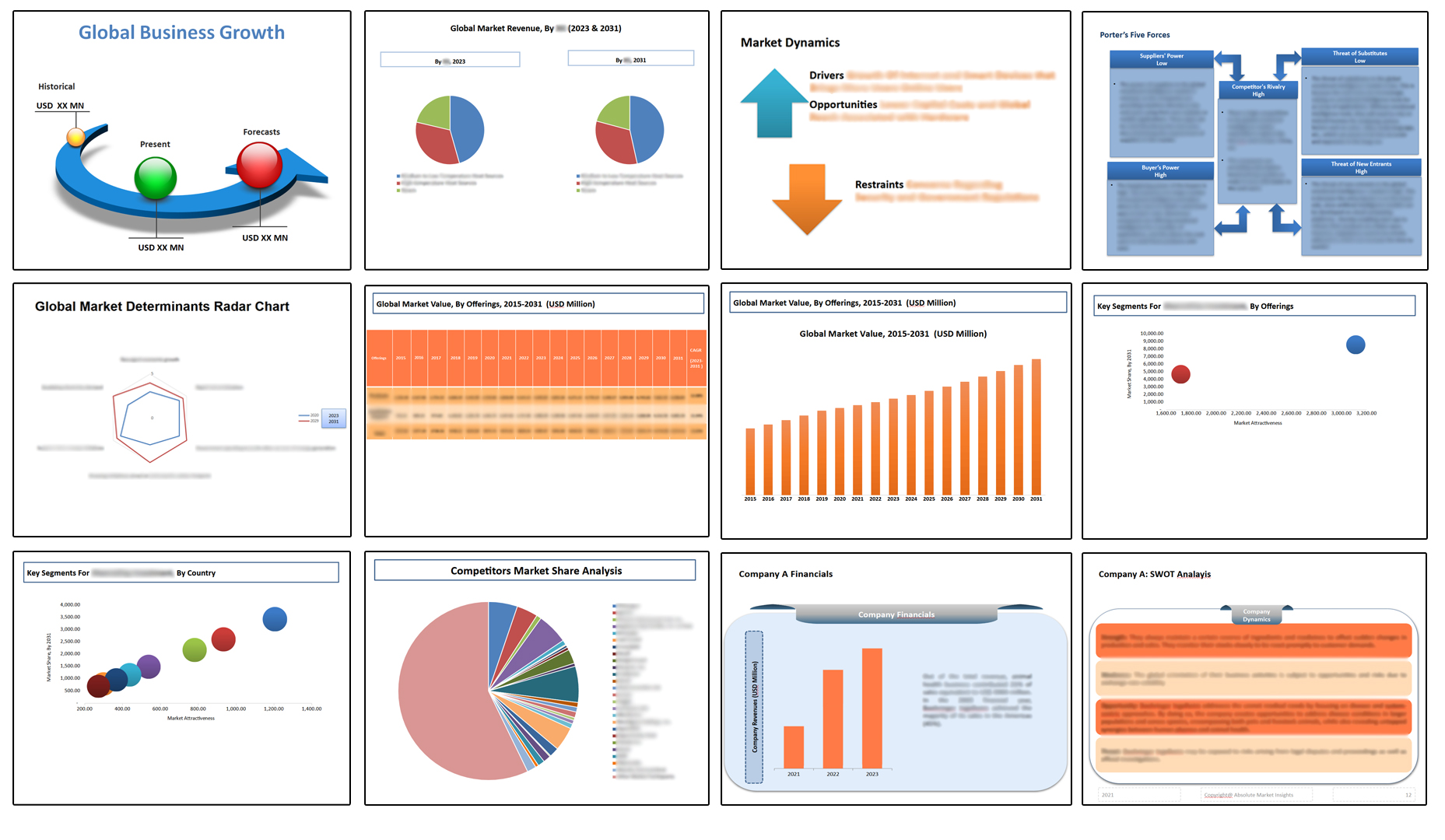
Table of Contents
Note: This ToC is tentative and can be changed according to the research study conducted during the course of report completion.
**Exclusive for Multi-User and Enterprise User.
Global Refinery Catalyst Market
By Ingredients
- Zeolites
- Metals
- Chemical Compounds
- Others
By Application
- FCC
- Alkylation
- Hydrotreating
- Hydrocracking
- Catalytic Reforming
- Others
By Region
- North America (U.S., Canada, Mexico, Rest of North America)
- Europe (France, The UK, Spain, Germany, Italy, Nordic Countries (Denmark, Finland, Iceland, Sweden, Norway), Benelux Union (Belgium, The Netherlands, Luxembourg), Rest of Europe)
- Asia Pacific (China, Japan, India, New Zealand, Australia, South Korea, Southeast Asia (Indonesia, Thailand, Malaysia, Singapore, Rest of Southeast Asia), Rest of Asia Pacific)
- Middle East & Africa (Saudi Arabia, UAE, Egypt, Kuwait, South Africa, Rest of Middle East & Africa)
- Latin America (Brazil, Argentina, Rest of Latin America)
The Niche Research approach encompasses both primary and secondary research methods to provide comprehensive insights. While primary research is the cornerstone of our studies, we also incorporate secondary research sources such as company annual reports, premium industry databases, press releases, industry journals, and white papers.
Within our primary research, we actively engage with various industry stakeholders, conducting paid interviews and surveys. Our meticulous analysis extends to every market participant in major countries, allowing us to thoroughly examine their portfolios, calculate market shares, and segment revenues.
Our data collection primarily focuses on individual countries within our research scope, enabling us to estimate regional market sizes. Typically, we employ a bottom-up approach, meticulously tracking trends in different countries. We analyze growth drivers, constraints, technological innovations, and opportunities for each country, ultimately arriving at regional figures.Our process begins by examining the growth prospects of each country. Building upon these insights, we project growth and trends for the entire region. Finally, we utilize our proprietary model to refine estimations and forecasts.
Our data validation standards are integral to ensuring the reliability and accuracy of our research findings. Here’s a breakdown of our data validation processes and the stakeholders we engage with during our primary research:
- Supply Side Analysis: We initiate a supply side analysis by directly contacting market participants, through telephonic interviews and questionnaires containing both open-ended and close-ended questions. We gather information on their portfolios, segment revenues, developments, and growth strategies.
- Demand Side Analysis: To gain insights into adoption trends and consumer preferences, we reach out to target customers and users (non-vendors). This information forms a vital part of the qualitative analysis section of our reports, covering market dynamics, adoption trends, consumer behavior, spending patterns, and other related aspects.
- Consultant Insights: We tap into the expertise of our partner consultants from around the world to obtain their unique viewpoints and perspectives. Their insights contribute to a well-rounded understanding of the markets under investigation.
- In-House Validation: To ensure data accuracy and reliability, we conduct cross-validation of data points and information through our in-house team of consultants and utilize advanced data modeling tools for thorough verification.
The forecasts we provide are based on a comprehensive assessment of various factors, including:
- Market Trends and Past Performance (Last Five Years): We accurately analyze market trends and performance data from preceding five years to identify historical patterns and understand the market’s evolution.
- Historical Performance and Growth of Market Participants: We assess the historical performance and growth trajectories of key market participants. This analysis provides insights into the competitive landscape and individual company strategies.
- Market Determinants Impact Analysis (Next Eight Years): We conduct a rigorous analysis of the factors that are projected to influence the market over the next eight years. This includes assessing both internal and external determinants that can shape market dynamics.
- Drivers and Challenges for the Forecast Period:Identify the factors expected to drive market growth during the forecast period, as well as the challenges that the industry may face. This analysis aids in deriving an accurate growth rate projection.
- New Acquisitions, Collaborations, or Partnerships: We keep a close watch on any new acquisitions, collaborations, or partnerships within the industry. These developments can have a significant impact on market dynamics and competitiveness.
- Macro and Micro Factors Analysis:A thorough examination of both macro-level factors (e.g., economic trends, regulatory changes) and micro-level factors (e.g., technological advancements, consumer preferences) that may influence the market during the forecast period.
- End-User Sentiment Analysis: To understand the market from the end-user perspective, we conduct sentiment analysis. This involves assessing the sentiment, preferences, and feedback of the end-users, which can provide valuable insights into market trends.
- Perspective of Primary Participants: Insights gathered directly from primary research participants play a crucial role in shaping our forecasts. Their perspectives and experiences provide valuable qualitative data.
- Year-on-Year Growth Trend: We utilize a year-on-year growth trend based on historical market growth and expected future trends. This helps in formulating our growth projections, aligning them with the market’s historical performance.
Research process adopted by TNR involves multiple stages, including data collection, validation, quality checks, and presentation. It’s crucial that the data and information we provide add value to your existing market understanding and expertise. We have also established partnerships with business consulting, research, and survey organizations across regions and globally to collaborate on regional analysis and data validation, ensuring the highest level of accuracy and reliability in our reports.


